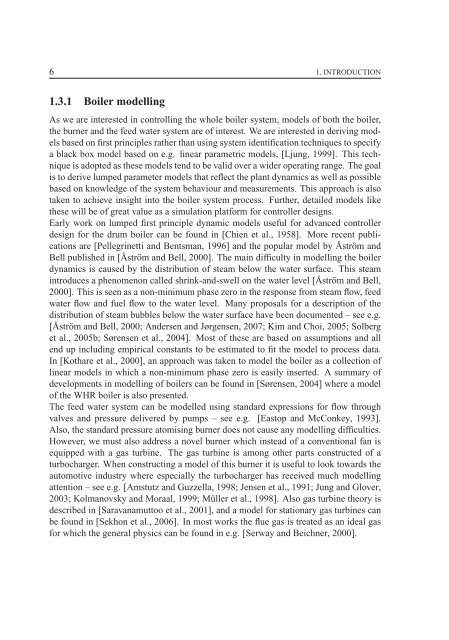Optimisation of Marine Boilers using Model-based Multivariable ...
Optimisation of Marine Boilers using Model-based Multivariable ...
Optimisation of Marine Boilers using Model-based Multivariable ...
Create successful ePaper yourself
Turn your PDF publications into a flip-book with our unique Google optimized e-Paper software.
6 1. INTRODUCTION<br />
1.3.1 Boiler modelling<br />
As we are interested in controlling the whole boiler system, models <strong>of</strong> both the boiler,<br />
the burner and the feed water system are <strong>of</strong> interest. We are interested in deriving models<br />
<strong>based</strong> on first principles rather than <strong>using</strong> system identification techniques to specify<br />
a black box model <strong>based</strong> on e.g. linear parametric models, [Ljung, 1999]. This technique<br />
is adopted as these models tend to be valid over a wider operating range. The goal<br />
is to derive lumped parameter models that reflect the plant dynamics as well as possible<br />
<strong>based</strong> on knowledge <strong>of</strong> the system behaviour and measurements. This approach is also<br />
taken to achieve insight into the boiler system process. Further, detailed models like<br />
these will be <strong>of</strong> great value as a simulation platform for controller designs.<br />
Early work on lumped first principle dynamic models useful for advanced controller<br />
design for the drum boiler can be found in [Chien et al., 1958]. More recent publications<br />
are [Pellegrinetti and Bentsman, 1996] and the popular model by Åström and<br />
Bell published in [Åström and Bell, 2000]. The main difficulty in modelling the boiler<br />
dynamics is caused by the distribution <strong>of</strong> steam below the water surface. This steam<br />
introduces a phenomenon called shrink-and-swell on the water level [Åström and Bell,<br />
2000]. This is seen as a non-minimum phase zero in the response from steam flow, feed<br />
water flow and fuel flow to the water level. Many proposals for a description <strong>of</strong> the<br />
distribution <strong>of</strong> steam bubbles below the water surface have been documented – see e.g.<br />
[Åström and Bell, 2000; Andersen and Jørgensen, 2007; Kim and Choi, 2005; Solberg<br />
et al., 2005b; Sørensen et al., 2004]. Most <strong>of</strong> these are <strong>based</strong> on assumptions and all<br />
end up including empirical constants to be estimated to fit the model to process data.<br />
In [Kothare et al., 2000], an approach was taken to model the boiler as a collection <strong>of</strong><br />
linear models in which a non-minimum phase zero is easily inserted. A summary <strong>of</strong><br />
developments in modelling <strong>of</strong> boilers can be found in [Sørensen, 2004] where a model<br />
<strong>of</strong> the WHR boiler is also presented.<br />
The feed water system can be modelled <strong>using</strong> standard expressions for flow through<br />
valves and pressure delivered by pumps – see e.g. [Eastop and McConkey, 1993].<br />
Also, the standard pressure atomising burner does not cause any modelling difficulties.<br />
However, we must also address a novel burner which instead <strong>of</strong> a conventional fan is<br />
equipped with a gas turbine. The gas turbine is among other parts constructed <strong>of</strong> a<br />
turbocharger. When constructing a model <strong>of</strong> this burner it is useful to look towards the<br />
automotive industry where especially the turbocharger has received much modelling<br />
attention – see e.g. [Amstutz and Guzzella, 1998; Jensen et al., 1991; Jung and Glover,<br />
2003; Kolmanovsky and Moraal, 1999; Müller et al., 1998]. Also gas turbine theory is<br />
described in [Saravanamuttoo et al., 2001], and a model for stationary gas turbines can<br />
be found in [Sekhon et al., 2006]. In most works the flue gas is treated as an ideal gas<br />
for which the general physics can be found in e.g. [Serway and Beichner, 2000].

















